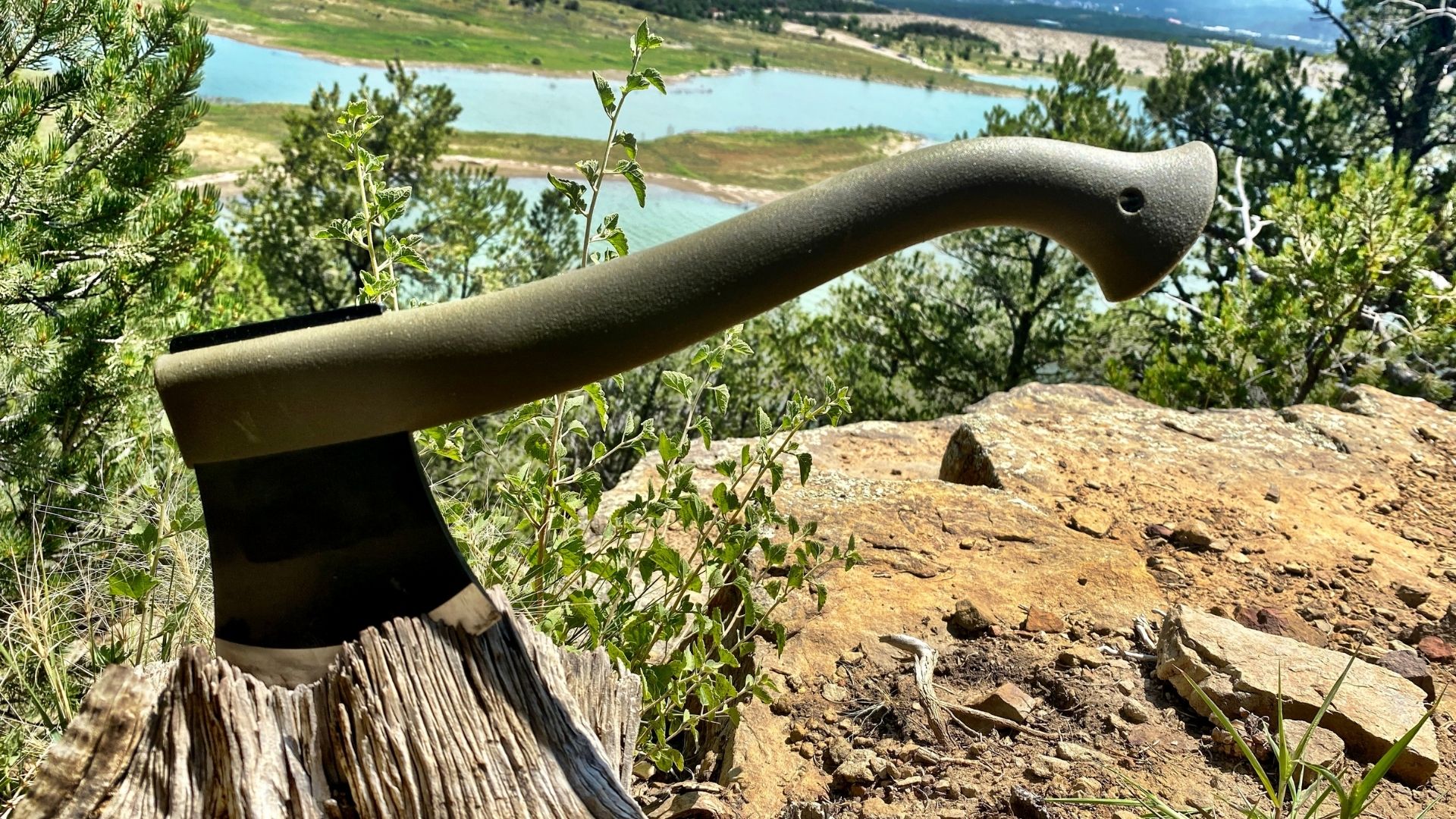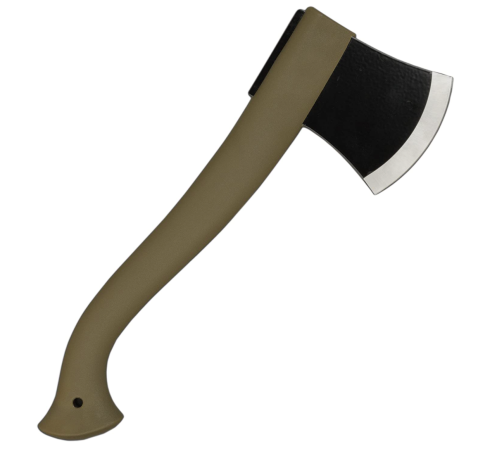

We may earn revenue from the products available on this page and participate in affiliate programs.
In the post-climate change era, having a campfire seems to be a thing of the past for those of us living in the deserts of the American Southwest or along the Pacific coast. Some would think this means that having a hatchet around is unnecessary. I disagree: as Gary Paulson demonstrated in the beloved classic young adult novel Hatchet, there are countless reasons to have a camping axe or hatchet handy. Whether it be for felling timber to construct a hasty shelter, for use in hammering in tent stakes into hard ground, for dressing game, or, yes, breaking down wood as tinder and kindling, there are a wide range of purposes served well by a hatchet.
When I saw that Morakniv was selling a reasonably-priced hatchet online, I immediately snatched one up. A Scandanavian company (its name comes from the town of Mora, Sweden) well-known for selling survival and craft knives, the Morakniv Outdoor Camp Axe is a mid-range, inexpensive hatchet designed for light backpacking use — and, as we discovered during testing, not intended for hard use.
Morakniv Outdoor Camp Axe
Unboxing
Morakniv packages its hatchet in a gray cardboard and transparent plastic box. The packaging is nothing fancy. Then again, the market for this hatchet is likely not buying the hatchet for its packaging but instead for its utilitarian value.
Out of the box, Morakniv’s Outdoor Camp Axe has a surprisingly good edge. Most axes come with a dull edge, probably so that they are safer while on display in stores. After all, who wants their precious little 9-year old to go all Jack Torrance on a display case — or their sibling — in the neighborhood hardware store?

The Morakniv Outdoor Camp Axe may be marketed as a ‘camp axe,’ but it is unquestionably a hatchet, as it is too small to wield in two hands. The hatchet has a 12.68-inch-long polymer plastic handle, in which sits the 4.53-inch-wide boron steel alloy head. Morakniv put a somewhat small 3.5-inch cutting edge on its hatchet compared to full-sized hatchets which frequently have longer cutting edges. This reflects the intent that the axe is for lightweight backpacking use.
The Morakniv Outdoor Camp Axe is extremely lightweight for a hatchet, coming in at just over a pound (17.64 ounces). The hatchet comes in two colors: hi-viz orange (Morakniv also offers the hi-viz orange as a bundle with its 2000 bushcraft knife for a reasonable price) or military green. The hatchet also comes with a leather sheath that covers just the cutting edge.
How we tested the Morakniv Outdoor Camp Axe
I have used the Morakniv Outdoor Camp Axe for just over a year now, and during backpacking trips in the Sangre de Cristo Mountains of New Mexico I found it great for setting up camp, helping me hammer in tent pegs into the hard ground of Rowe Mesa. It is also great for stripping branches off saplings for an improvised lean-to pole.
For this review’s particular test, I put the Outdoor Camp Axe up against the Estwing Camper’s Axe. In terms of dimensions, the Estwing is 16 inches long, with a four-inch-long cutting face, or relatively comparable to the Morakniv Outdoor Camp Axe. I brought both hatchets down to Reilly Canyon, in Trinidad Lake State Park, Colorado, where I timed how long it would take to cut a three-inch by one-inch channel in a log.

My timer running, I began hacking at the log with the Morakniv Outdoor Camp Axe. The lightweight axe first struggled to bite into the log; eventually, I found the right angle for it and was able to cut out the small channel in the wood, but it was clear the hatchet was not meant for this sort of work. With the Morakniv, I was able to carve a channel in 2 minutes and 20 seconds. With the Estwing, a beaten up hatchet I rarely sharpened and used frequently, I was able to chop a channel in 1 minutes and 24 seconds.
Why the substantial variance in time? Even though the Morakniv had a sharper edge than the Estwing, the Estwing’s four extra inches and heavier metal handle meant extra leverage for harder swings. Because the Morakniv’s handle was shorter, I think I was less willing to swing with full force and risk hitting myself with the axe head.
What we like about the Morakniv Outdoor Camp Axe
The hatchet is an example of good design resulting in reduced weight. Most camping hatchets come in at two pounds or more; the Morakniv Outdoor Camp Axe is just under half that weight. While greater weight means that an axe or hatchet has a greater ability to power through a piece of wood, a lighter weight means that it’s less of a burden when backpacking.
Down the road, though, a dull axe or hatchet is a dangerous axe or hatchet. Morakniv’s boron steel alloy head not only comes with a sharp edge, but the alloy maintains that edge well, too. I found it was also easy to maintain that edge with a belt sharpener.

The polymer plastic handle is ergonomic and has yet to generate any blisters during use. I really did not have high expectations for the handle, so this turned out to be a pleasant surprise. My low expectations came from the weight of the handle. I suspect a wooden, shock-absorbing handle would be better for long-term use, such as when I start gathering cordage for the winter. However, if I am on a camping trip, and I just need a bit of kindling or want to clear branches from wood, this hatchet is more than sufficient. Is this the sort of hatchet I would use for a bushcraft trip? Probably not. That being said, the three-season sleeping bag I use would not be appropriate for Annapurna, yet it still comes with me on trips into the local mountains.
What we don’t like about the Morakniv Outdoor Camp Axe
I found the handle on the Morakniv Outdoor Camp Axe a little short for my liking, even for a one-handed tool. I would rather be able to choke up on a 16-inch-long handle than be incapable of gaining a little safe distance on a 12-inch-long handle. This was especially true in situations where I was using the hatchet from a standing position. Even with a proper crouched hatchet stance, I found that the hatchet came awfully close to my inseam — and my femoral artery — on some swings. Additionally, because of the lightweight nature of the hatchet, it seemed harder to control and direct force at the desired point of impact.
Chances are, there could be a better cover for the hatchet. Morakniv includes a black leather cover that protects just the cutting edge of the hatchet and is fastened with a snap. The cover is adequate, but I would consider buying a cover that protects other items in my pack from the entirety of the axehead. This is not a dealbreaker, obviously, as there are plenty of aftermarket hatchet covers, such as this one from Hide & Drink.
Verdict
Aside from the concerns regarding the length of the Outdoor Camp Axe’s handle, the weight of the hatchet, and the small cover, the Morakniv is the right size to be slipped in an internal frame pack or to lashed onto a bushcraft rucksack. The ergonomic handle design speaks well for Morakniv’s design team. So, too, does the sharp-out-of-the-box axehead. While I would not consider the Morakniv the right size for a few hours of gathering or splitting firewood, it suffices on the trail.
FAQs about the Morakniv Outdoor Camp Axe
Q. How much does the Morakniv Outdoor Camp Axe cost?
A: Amazon lists the hatchet for $53.60. The Outdoor Camp Axe also comes as part of a set with the Morakniv 2000 that, while hard to come by, is a good value at $85.15.
Q. What’s the best-use case scenario for the Morakniv Outdoor Camp Axe?
A: The Outdoor Camp Axe is intended for light use, perhaps for hammering tent stakes into the ground or chopping tinder and kindling. It would likely be nightmarish to use for splitting logs or felling trees.
Q. Does the Morakniv Outdoor Camp Axe come with a sheath or carrying case?
A: Yes, Morakniv includes a snap-on leather cover that protects just the tip of the axehead.
Q. Is the Morakniv Outdoor Camp Axe easy to open?
A: Unless you struggle with snaps, it’s a cinch.
Q. What are some alternatives to the Morakniv Outdoor Camp Axe?
A: The Estwing Camper’s Axe ($72.01) is a more robust — albeit heavier — alternative to the Outdoor Camp Axe. Condor Tool and Knife offers the Scout Hatchet for $50.56, but its 10.25-inch handle is even shorter than that of the Outdoor Camp Axe. If money (and perhaps common sense) is no barrier for you, Hults Bruk is a boutique Swedish brand of high-quality axes, likely owned exclusively by hipsters who reside in Portland. Their Almike 16-inch hatchet would be comparable to the Outdoor Camp Axe, and it only costs $169.00. For that price, you might as well get a chainsaw. The Almike comes with a holster because that makes sense.
Q. What’s the difference between a hatchet and an axe?
A: A hatchet is generally intended to be used with one hand; an axe is intended to be used with a two-handed grip. Therefore, Morakniv has inadvertently mislabeled its hatchet by calling it an Outdoor Camp Axe. This should not drive me nuts, but it does.
Got questions? Comment below & talk with T&P’s editors.
We’re here to be expert operators in everything How-To related. Use us, compliment us, tell us we’ve gone full FUBAR. Comment below and let’s talk. You can also shout at us on Twitter or Instagram.
Todd Brogowski served in the Army as a human intelligence collector. Originally from New Jersey, he currently works as a freelance photojournalist and crime reporter in Colorado and New Mexico. Previously, he worked in the Pacific Northwest as an investigator and fraud examiner.
